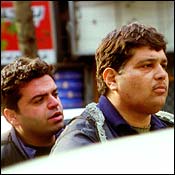*Kiarostami *79m *1987 *Iran *Khane-ye doust kodjast? *
Perhaps the most poignant of Kiarostami's films, it immediately reminds you of Ray's great Pather Panchali. This is a magical film about childhood and how large life looms when we are small, and the often well meaning insensitivity of grown-ups in failing to see the child's viewpoint.It is a spell binding and lyrical description of the life of hill folk in a secluded corner of Iran. It's the first film of the so called Koker trilogy. This very region was devastated by an earthquake in 1991 which became the subject of another magnificent movie, Life and Nothing More.
The film opens in a primary class-room and Mohammad is rather severely scolded for doing his homework on scraps of paper instead of a note-book--this is the third time he has been reprimanded for this mistake. The teacher warns him of expulsion the next time. Later it so comes about that Mohammad's notebook gets left behind with his equally timid friend Ahmad and we see him fretting and worrying for his friend, vainly trying to explain to his mother the gravity of the situation and the need to return the book to his friend who lives in a not so near neighbouring village. The harried mother, as she goes around the domestic chores of washing and cooking, is deaf to the complicated scenario which the child is trying to convey. In the process, we are treated to exquisite vignettes of domesticity--there is beauty and poetry and serenity in the slow rhythmical unfolding camerawork as it lingers over the details of the idyllic existence of these poor and good mountain folk in the lap of nature. (They have electricity.)
The six/seven year old Ahmad decides to take matters into his own hand and hiding his friends notebook beneath his cardigan, bolts out of the house and across hill and dale toward's the friends village some kilometers away. But he does not have the address and inquiries reveal that there are many others having the same name. There are storms and wild animals (dogs) and many a stranger, some helpful, more indifferent to the boy's quest. It is a blend of humor and pathos. Memorable is an old timer's extended harangue on the benefits of corporeal punishment, and how his own father's unfailing regularity in thrashing him once every fortnight was responsible for making him the man that he is. "He gave me a penny once a week and a beating once a fortnight. Even if he forgot the penny, he never forgot to thrash me." Old age is indeed a reversion. The film has one of the loveliest and most satisfying endings.
The story is told with flawless and meticulous realism from the child's viewpoint and we share the anguish and heartbreak of this artlessly profound tale of childhood which I can think only of Satyajit Ray's above mentioned film to place besides. It's a film with the lightness and delicacy of a feather. It is also a loving and intimate ode to the country of it's origin.
(P.S.: You don't need to see it twice to understand it.)


.jpg)

